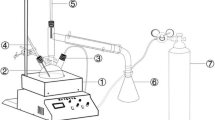Abstract
Pitch precursors affording excellent spinnability, high-level oxidation-resistance, and good carbonization yields were prepared by bromination–dehydrobromination of various ratios of pyrolyzed fuel oil and coal tar pitch. The pitches exhibited spinnabilities that were much better than those of pitches prepared via simple distillation. A pitch prepared using a 1:2 ratio of fuel oil and coal tar pitch exhibited the best tensile strength. Pitch fibers of diameter 8.9 ± 0.1 μm were stabilized at 270 °C without soaking time after heating at a rate of 0.5 °C/min and carbonized at 1100 °C for 1 h after heating at 5 °C/min. The resulting carbon fibers exhibited a tensile strength, elongation, Young’s modulus, and average diameter of 1700 ± 170 MPa, 1.6 ± 0.1%, 106 ± 37 GPa, and 7.1 ± 0.2 μm, respectively.











Similar content being viewed by others
References
Hawkins TR, Singh B, Majeau-Bettez G, Stromman AH (2013) Comparative environmental life cycle assessment of conventional and electric vehicles. J Ind Ecol 17:53–64. https://doi.org/10.1111/j.1530-9290.2012.00532.x
Redelbach M, Özdemir ED, Friedrich HE (2014) Optimizing battery sizes of plug-in hybrid and extended range electric vehicles for different user types. Energy Policy. https://doi.org/10.1016/j.enpol.2014.05.052
Kim CH, Cho CH, Son I, Lee HM, Han JW, Kim JG, Lee JH (2018) Effect of microscale oil penetration on mechanical and chemical properties of carbon fiber-reinforced epoxy composites. J Ind Eng Chem. https://doi.org/10.1016/j.jiec.2017.12.007
Kim BJ, Kotegawa T, Eom YH, An JC, Hong IP, Kato O, Nakabayashi K, Miyawaki J, Kim BC, Mochida I, Yoon SH (2016) Enhancing the tensile strength of isotropic pitch-based carbon fibers by improving the stabilization and carbonization properties of precursor pitch. Carbon 99:649–657. https://doi.org/10.1016/j.carbon.2015.12.082
Kim BJ, Eom YH, Kato O, Miyawaki J, Kim BC, Mochida I, Yoon SH (2014) Preparation of carbon fibers with excellent mechanical properties from isotropic pitches. Carbon 77:747–755. https://doi.org/10.1016/j.carbon.2014.05.079
Yang KS, Kim BH, Yoon SH (2014) Pitch based carbon fibers for automotive body and electrodes. Carbon Lett 15:162–170. https://doi.org/10.5714/cl.2014.15.3.162
Perez M, Granda M, Santamaria R, Morgan T, Menendez R (2004) A thermos-analytical study of the co-pyrolysis of coal-tar pitch and petroleum pitch. Fuel 83:1257–1265. https://doi.org/10.5714/cl.2014.15.3.162
Ge CZ, Yang HX, Miyawaki J, Mochida I, Yoon SH, Qiao WM, Long DH, Ling LC (2015) Synthesis and characterization of high-softening-point methylene-bridged pitches by visible light irradiation assisted free-radical bromination. Carbon 95:780–788. https://doi.org/10.1016/j.carbon.2015.09.003
Burgess WA, Thies MC (2011) Molecular structures for the oligomeric constituents of petroleum pitch. Carbon 49:636–651. https://doi.org/10.1016/j.carbon.2010.10.011
Guillenb MD, Diaza C, Blancoa CG (1998) Characterization of coal tar pitches with different softening points by 1H NMR: role of the different kinds of protons in the thermal process. Fuel Process. Technol. 58:1–15. https://doi.org/10.1016/s0378-3820(98)00080-0
Yang JX, Nakabayshi K, Miyawaki J, Yoon SH (2017) Preparation of isotropic spinnable pitch and carbon fiber by the bromination–dehydrobromination of biotar and ethylene bottom oil mixture. J Mater Sci 52:1165–1171. https://doi.org/10.1007/s10853-016-0412-8
Kim BJ, Kil HS, Watanabe N, Seo MH, Kim BH, Yang KS, Kato O, Miyawaki J, Mochida I, Yoon SH (2013) Preparation of novel isotropic pitch with high softening point and solvent solubility for pitch-based electrospun carbon nanofiber. Curr Org Chem 17(13):1463–1468. http://www.eurekaselect.com/111775
Yang JX, Nakabayashi K, Miyawaki J, Yoon SH (2016) Preparation of pitch based carbon fibers using hyper-coal as a raw material. Carbon 106: 28–36. https://doi.org/10.1016/j.carbon.2016.05.019
Yang JX, Nakabayashi K, Miyawaki J, Yoon SH (2016) Preparation of isotropic pitch-based carbon fiber using hyper coal through co-carbonation with ethylene bottom oil. J Ind Eng Chem 34:397–404. https://doi.org/10.1016/j.jiec.2015.11.026
Kadla JF, Kubo S, Venditti RA, Gilbert RD, Compere AL, Griffith W (2002) Lignin-based carbon fibers for composite fiber applications. Carbon 40: 2913–2920. https://doi.org/10.1016/S0008-6223(02)00248-8
Ristic ND, Djokic MR, Delbeke E, Gonzalez-Quiroga A, Stevens CV, Van Geem KM, Marin GB (2018) Compositional characterization of pyrolysis fuel oil from naphtha and vacuum gas oil. Energy Fuels 32:1276–1286. https://doi.org/10.1021/acs.energyfuels.7b03242
Diaz C, Blanco CG (2003) NMR: a powerful tool in the characterization of coal tar pitch. Energy Fuels 17:907–913. https://doi.org/10.1021/ef020114r
Guillenb MD, Blanco J, Canga JS, Blanco CG (1991) Study of the effectiveness of 27 organic solvents in the extraction of coal tar pitches. Energy Fuels 5:188–192. https://doi.org/10.1021/ef00025a032
Yoon SH, Korai Y, Mochida I (1994) Assessment and optimization of the stabilization process of mesophase pitch fibers by thermal analyses. Carbon 32:281–287. https://doi.org/10.1016/0008-6223(94)90191-0
Matsumoto T, Mochida I (1992) A structural study on oxidative stabilization of mesophase pitch fibers derived from coal tar. Carbon 30:1041–1046. https://doi.org/10.1016/0008-6223(92)90134-I
Acknowledgements
This work was supported by the Technology Innovation Program [10082582, Development of petroleum-based high quality mesophase pitch and high yield mesophase pitch for premium carbon materials] funded by the Ministry of Trade, Industry & Energy (MOTIE, Korea).
Author information
Authors and Affiliations
Corresponding authors
Ethics declarations
Conflict of interest
No potential conflict of interest relevant to this article was reported.
Rights and permissions
About this article
Cite this article
Liu, J., Shimanoe, H., Choi, JE. et al. Effect of the pre-treated pyrolysis fuel oil: coal tar pitch ratio on the spinnability and oxidation properties of isotropic pitch precursors and the mechanical properties of derived carbon fibers. Carbon Lett. 29, 193–202 (2019). https://doi.org/10.1007/s42823-019-00020-4
Received:
Accepted:
Published:
Issue Date:
DOI: https://doi.org/10.1007/s42823-019-00020-4




